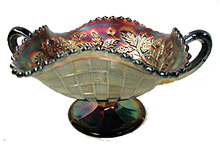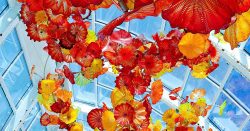There are various names for antique Carnival glass including; Poor Mans Tiffany, Rainbow Glass, Aurora Glass and Taffeta Glass. The variety and enormous range of patterns means that glass collectors will always be searching for more pieces.
But making sure your acquisitions are genuine antique carnival glass is all important. Many modern glass manufacturers reintroduced lines, copied old original patterns and created more modern patterns when carnival glass became popular in the 1950's.
Carnival glass was first produced in the early nineteen hundreds, and is a range of patterned, pressed glass suffused with an iridescent lustre, which reflects the light, making the surface gleam with metallic highlights.
Contents
America was the first country to produce carnival glass in commercial quantities.
The five biggest companies were Northwood Glass, Fenton Art Glass, Imperial, Dugan and Millersburg. Each manufacturer had their own patterns and specialities. There were also a few smaller countries which produced carnival glass including England, Australia, Czechoslovakia, Argentina, Estonia, Finland and Sweden.
Carnival glass is actually pressed glass (formed in a mold) with an iridescent sheen, with the addition of rainbow colors that give it that oil on water appearance.
It was made to be admired and many styles of vases, candy dishes, compotes, pitcher and beverage sets, powder boxes, piggy banks, trays and other decorative and useful wares were created. The ability to mass produce the glass allowed it to be sold at reasonable prices.
Tiffany and other companies had been making iridescent glass, but in the 1880's pressed glass was introduced into the United States.
Carnival glass was often called the poor man’s Tiffany and brightened up dreary homes. Its affordable price made it immensely popular in the early part of the 1900's.
Traditional colors include translucent marigold, amethyst, cobalt, green, red, and white (milk glass). Pastel colors were less common.
Carnival glass gets its iridescent sheen from the metallic salts which are applied while it is still hot from the mold. The piece is then refired, creating the rainbow effect.
Fenton was the first and largest producer of carnival glass in the U.S., and called it Venetian Art Glass.
It was instantly popular and known for its high quality. Other glass makers followed Fenton’s lead and began producing their own lines of carnival glass. Northwood was another huge manufacturer, and the only glass company that consistently marked their wares. Other companies that mass produced carnival glass were Dugan (later Diamond), U.S. Glass, Imperial, Millersburg, Cambridge and Westmoreland, but there were also smaller glass manufacturers.
Fenton began producing carnival glass in 1907, and their wares sold as fast as they could produce them. Carnival glass was often given away at carnivals when it was first new, and was desirable prize because it was a lovely thing you could take home to mom. Society folks, who looked down on the common carnival-goers, didn’t care for the association. When her lady’s maid could own the same lovely glassware as her mistress, interest began to wane.
The demand began to taper off around 1925, and by 1931 there were no glass companies producing carnival glass.
Production outside the U.S. continued through the 1930's.
In the 1950's, when collectors began to show an interest in antique carnival glass and it became fashionable again, some glass manufacturers reintroduced carnival glass in both the old designs and some new ones.
Fenton took care to mark their reproductions, but many other manufacturers were not as considerate.
There are over 2000 patterns of Carnival glass, and manufacturers would take advantage of the lax copyright laws and copy their competitors patterns.
The lack of markings makes it difficult to tell antique carnival glass from newer productions. It sometimes takes an expert to tell the difference.
Matching patterns, sheen, colours, edges, thickness and other components of the glass in a manufacturers catalogue may help the collector distinguish antique or vintage carnival glass from more modern reproductions.
Contemporary pieces are collectible, but some are more valuable than others and there are many good carnival glass collectors’ guides available to help you identify genuine carnival glass from these contemporary pieces and reproductions.
Finding rare and collectible examples of antique Carnival glass bowls, dishes and vases will add value to your glass collection . Click to Learn More About Collecting Carnival Glass




